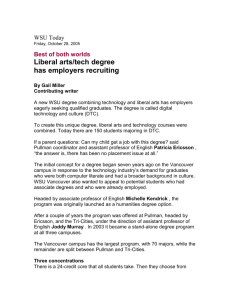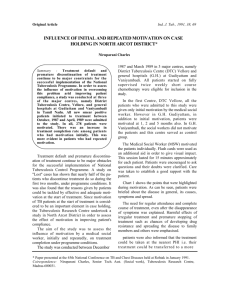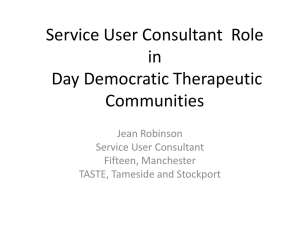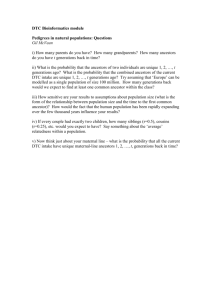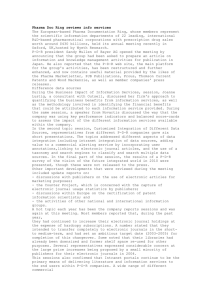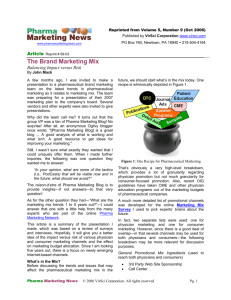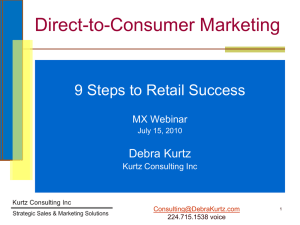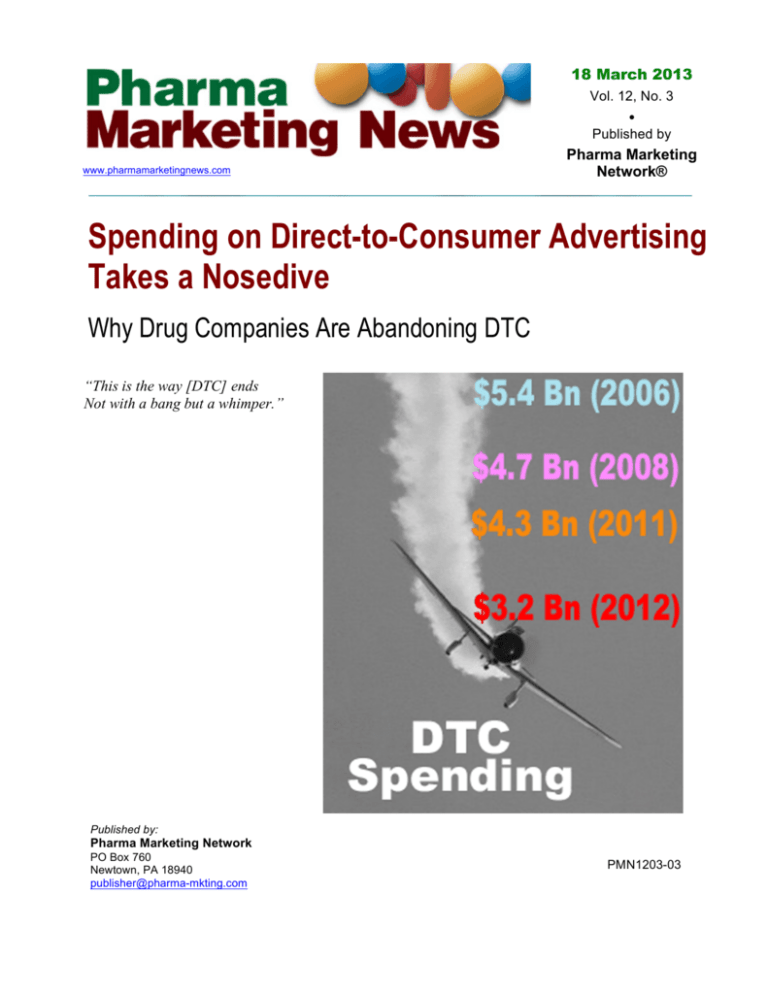
18 March 2013
Vol. 12, No. 3
•
Published by
www.pharmamarketingnews.com
Pharma Marketing
Network®
Spending on Direct-to-Consumer Advertising
Takes a Nosedive
Why Drug Companies Are Abandoning DTC
“This is the way [DTC] ends
Not with a bang but a whimper.”
Published by:
Pharma Marketing Network
PO Box 760
Newtown, PA 18940
publisher@pharma-mkting.com
PMN1203-03
Pharma Marketing News
Vol. 12, No. 3: March 18, 2013
D
irect-to-Consumer (DTC) advertising took a
nosedive in 2012. According to data from
cegedim Strategic Data (CSD), DTC spending
decreased by 22% in 2012 compared to 2011(see
Figure 1, below).
The Downward Spending Spiral
The last time DTC spending decreased by doubledigital percentage points was in the recession of 2008,
which saw a 10% drop in DTC spending compared to
2007. The decline in DTC spending has been more or
less steady since the 2006 when the industry spent
more than $5.4 billion (see Figure 2, page 3).
Industry pundits with skin in the game such as Bob
Ehrlich of DTC Perspectives magazine, see the DTC
glass half full instead of half empty. Actually, the glass
is 40% empty/60% full; i.e., the 2012 spend was about
60% of the 2006 spend.
“While no one, particularly media outlets, thinks of 20%
declines as good news, we must keep the latest decline
in context,” said Ehrlich in an editorial. “New brands and
new categories will use DTC. Most will get a payback of
$1.5-2.5 dollars to each one invested. Some will fail
badly. Some of those should have not done DTC because it does not work well for all brands or categories.”
p. 2
Execs Think It’s Time to Trim DTC
Some pharmaceutical executives—including current
CEOs and former VPs—present a different view of
DTC. Joseph Jimenez, the CEO of Novartis, for
example, lamented the fact that spending on marketing
was taking away money better spent on research and
development of news drugs.
In a video interview with the Wall Street Journal
Jimenez said "The industry needs to spend more
money on R&D and less on sales and marketing. In the
past two decades, a lot of the value creation came from
sales and marketing muscles for new drugs. And now
there is probably less investment by some companies
to ensure that there is going to be a continuous flow of
innovation" (see "Spend Less Money on Sales &
Marketing, Says Novartis Chief Joseph Jimenez”;
http://bit.ly/XI2Zs5).
John LaMattina, former Pfizer president of Research
and Development, said in his new book “Devalued and
Distrusted” that drug TV ads "may be doing more harm
than good. The litany of side-effects that must be discussed is numbing and probably doesn’t provide a
sense of the true risk-benefit for that medication” (see
Continues…
Figure 1. Annual Changes in
Channel Spending. Source:
cegedim Strategic Data (CSD);
http://bit.ly/ZVuyDc The
numbers below channel names
are 2012 spend (in $Millions).
Note: CSD did not have data for
the change in print advertising
spending for 2011-2012. The 50% bar shown here was
estimated so that the total
spending in 2012 equaled the
$27,354.7 million cited by CSD.
© 2013 Pharma Marketing Network (www.pharma-mkting.com). All rights reserved.
Pharma Marketing News
PMN1203-03
Pharma Marketing News
Vol. 12, No. 3: March 18, 2013
“Bad, Devalued, Distrusted & Defensive Pharma: A
Tale of Two Books”; http://bit.ly/ZeDXVd). LaMattina,
however, doesn’t believe such ads take money away
from R&D, although he thinks the public believes so:
“Plus, the public views these ads to be a waste of funds
that could otherwise be invested in R&D or in lessening
drug costs." The public may also think the ads are
causing people to self-diagnose (see “An Anti-DTC
Crossword Puzzle”; page 4).
What Are the Causes?
Not so long ago, the drug industry was up against a
public and legislative onslaught that threatened to ban
DTC altogether (see “To Ban or Not to Ban DTC, That
is the Question”; http://bit.ly/10RUAX2). But it now
appears that DTC will not end with a bang, but with a
whimper.
What is causing the whimpering end of DTC?
As many experts have pointed out, there are several
likely causes, including the recession of 2007-2008,
shrinking pipeline (fewer new drugs means fewer ads),
and the rise of generics (which generally are not
advertised).
p. 3
One cause not often mentioned is a shift in developing
drugs for small populations of patients (so-called “orphan” drugs) and complex biologics, which may also be
targeted to small populations. It’s not economical to
reach potential patients for these products using expensive broadcast advertising.
Could the rise of orphan drugs and biologics be a factor
in the most recent 22-26% drop in DTC spending (2012
compared to 2011)?
Pfizer’s Xalkori (crizotinib), for example, is approved for
a rare form of lung cancer. Pfizer plans to charge
$115,200 a year per patient for this drug (see “Big
Pharma's Future: Niche Mega Blockbusters”;
http://bit.ly/YwmNPI). At that rate, Pfizer needs only
about 9,000 patients worldwide to generate $1 billion in
annual sales of Xalkori. In comparison, 1,671,000
Lipitor patients are required to generate the same level
of sales.
Continues…
Figure 2. DTC Measured Media Ad
Spend. Source: Nielson. The three 2012
bars are estimates calculated as follows:
the BLUE estimate ($4.16 Bn) is based on
the loss of Lipitor advertising (see “Lipitor
Holds Key to DTC Ad Spending in 2012”;
http://bit.ly/TWJAJ2). This is obviously
too optimistic—it only takes into account
the loss of Lipitor brand advertising,
everything else remaining the same. The
PINK estimate ($3.35 Bn) is based on
CSD's estimate of a 22% decrease in
spending in 2012 compared to 2011 ($4.30
Bn). The ORANGE estimate is based on
Nielsen data comparing Q2 spending in
2012 vs 2011 ($0.896 Bn vs 1.137 Bn,
respectively). You can find that data here:
http://bit.ly/1411k9F. That's a 21%
decrease. To calculate a total for 2012, the
following assumption was used: The ratio
of Q2 spending in 2012 to the 2012 total is
equal to the ratio of Q2 spending in 2011
to the 2011 total. The equation is: (Q22012/x) = (Q2-2011/Total-2011). Based on
the available data, x = $3.15 Bn, which is
about 27% less than the total DTC spending for 2011. That's quite a nosedive!
© 2013 Pharma Marketing Network (www.pharma-mkting.com). All rights reserved.
Pharma Marketing News
PMN1203-03
Pharma Marketing News
Vol. 12, No. 3: March 18, 2013
Rise of Biologics
Recently, the sales of biologics have taken off. Biologics are complex, difficult to produce, and cost
thousands of dollars per treatment. On top of that, they
are often targeted to a small group of patients genetically predisposed to benefit the most. All this means
that DTC advertising may not be a cost-effective means
of increasing scripts for these products.
Forbes published a list of "Best Selling Drugs of All
Time," the peak sales of which are plotted in Figure 3
below. This chart highlights the many biologics that are
part of the list. Most of these biologics have not yet
reached the all-time sales records of DTC-advertised
pills. Given time, however, we are likely to see an even
higher proportion of biologics on this list.
p. 4
Avastin, exceeding $100,000 per year. Given that use
of new biologics is concentrated among a smaller number of patients with relatively rare conditions treated
primarily by specialists, we would expect promotion to
providers and consumers to also be highly targeted."
A Change in Paradigm
Pfizer is confident it can find patients for Xalkori through
diagnostic tests that pinpoint patients most likely to
benefit. "There's been a change of paradigm," said a
Pfizer researcher. "The new school of thought is, 'If you
find the patients that the drug will work in, and if you
see enough benefit, we will find a way to get this to
market.”
Continues…
An Anti-DTC Crossword Puzzle
Anti-DTC sentiment has worked its way into
popular culture. Even crossword puzzles these
days reference DTC ads and NOT in a good way.
The following puzzle published in Newsday is an
example.
Below is the partial solution to the puzzle titled
"HEAL THYSELF?" published in Newsday on
February 15, 2012 (accessed via iPad). The
theme message of the puzzle is a three-part quip
answer to the title. The solution fits in the
highlighted empty squares. Can you solve it?
Figure 3. Peak Year Sales of Top Drugs. Source: Forbes;
http://onforb.es/159Ht3V
Table 1, page 5, shows the top US-selling biologics (in
2010) along with product-specific expenditures and
promotional spending toward consumers and providers.
Although these are 2010 data, we can see that relatively little was spent on DTC advertising for these 25
top selling biologics—a total of $189.5 million compared to $4,371 million for total 2010 DTC spending,
according to data from this source.
"Declining promotion may also reflect the increasing
biologics share of the market," suggest the authors of
the PLOS study cited in Table 1. "Declines in DTCA
may accelerate as biologics make up a greater share of
new therapies. Biologics often have unique routes of
delivery and storage and can be very costly compared
to small molecules, with costs for one cancer drug,
Find the answer here: http://bit.ly/10YhKim
© 2013 Pharma Marketing Network (www.pharma-mkting.com). All rights reserved.
Pharma Marketing News
PMN1203-03
Pharma Marketing News
Vol. 12, No. 3: March 18, 2013
The new drug development "paradigm" requires a new
marketing paradigm as well. That marketing paradigm
will focus almost exclusively on medical specialists such
as oncologists. Under this paradigm it will be difficult to
justify broadcast DTC advertising (e.g., TV) because it
will cost too much to reach the small group of potential
patients with such a broad brush.
Targeted Advertising
Pharma marketers are likely to use broadcast DTC only
when the target audience is greater than 10% of the
adult population. For smaller markets targeted advertising works best. What's the best medium for "targeted"
advertising? Well, it’s not TV or even print (magazines).
It’s the Internet, stupid!
p. 5
However, as the PLOS study authors note, "Although
relative increases in DTCA through media such as the
Internet and social networking have occurred, these
expenditures remain a small fraction of overall consumer-targeted promotion." According to the authors'
data, Internet DTC spending in 2010 (not including
search advertising) represented only 4.6% of the total
DTC spend for that year.
What about 2011 and 2012? Has the percent of Internet
spending versus total DTC spending increased significantly? Data from 2011 suggests this percent was
4.7%; i.e., no increase (see Figure 4, page 6). Low
pharma online spending in 2012 was also mentioned
Continues…
Table 1. Promotional Spending on Biologics. Source: "Promotion of Prescription Drugs to Consumers and Providers, 2001–2010";
http://bit.ly/13XTD3T
© 2013 Pharma Marketing Network (www.pharma-mkting.com). All rights reserved.
Pharma Marketing News
PMN1203-03
Pharma Marketing News
Vol. 12, No. 3: March 18, 2013
as a factor in the downsizing of WebMD (see “Decline
in Online Drug Advertising Leads to 14% Downsizing at
WebMD,” below).
It seems that pharma marketers either don't have to do
much DTC marketing of any sort to sell orphan drugs or
biologics or they haven't figured out how to use the
Internet to do targeted marketing of these products to
consumers.
Meanwhile, Ehrlich believes DTC is merely experiencing a “lull.” “I have never been more encouraged by
the DTC opportunity,” said Ehrlich, who predicts DTC
spending can once again reach $5 billion, even $10
billion annually.
p. 6
Between the desire
And the spasm
Between the potency
And the existence
Between the essence
And the descent
Falls the Shadow
This is the way the world ends
This is the way the world ends
This is the way the world ends
Not with a bang but a whimper.
Pharma Marketing News
Decline in Online Drug Advertising Leads to
14% Downsizing at WebMD
(Originally published on Pharma Marketing Blog;
http://bit.ly/ZFBJMn)
There may be no better bellwether for the state of online
pharma advertising than the health of WebMD, a leading
website that depends on health industry—mostly pharma—
advertising.
In a December 11, 2012, press release, WebMD announced "a
comprehensive program to streamline its operations, reduce
costs and better focus its resources on increasing user
engagement, improving customer satisfaction and driving
innovation." By "streamline," WebMD means laying off 250
employees, about 14% of the company's workforce.
According to Tech Crunch:
"During its most recent quarterly results, the company saw
revenue decline from $135 million during the year ago
period to $117 million, with sponsorship and advertising
income especially taking a downward turn. WebMD
reported a net loss of $900K on the quarter, compared to
positive income of $14.2 million during the same quarter
last year. Still, its site traffic continues to grow, according
to its quarterly financials, with 22 and 24 percent increases
for unique visitors per month and page views between Q3
2011 and Q3 2012. So what’s behind the losses and the
resulting need for budget cuts? Despite a growing
audience, it seems like advertisers are either less
interested or less able to create campaigns on WebMD."
Figure 4. Allocation of DTC Spending Dollars
(2011). Source: http://bit.ly/DTCspend
Back in January, 2012, the Wall Street Journal reported that
WebMD's Chief Executive Wayne T. Gattinella resigned, and the
health-website operator "called off a search for a buyer as it
braces for weaker financial results this year. A key issue, the
company said, is pharmaceutical companies holding back on
spending as they deal with expiring drug patents."
© 2013 Pharma Marketing Network (www.pharma-mkting.com). All rights reserved.
Pharma Marketing News
PMN1203-03

